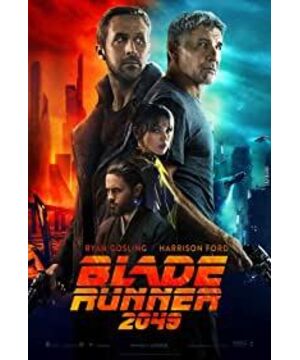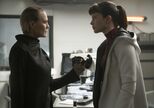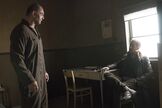Thirty-five years ago, the classic "Blade Runner" in the history of science fiction movies was released. Thirty-five years later, the film's sequel "Blade Runner 2049" landed on global theaters and caused quite a stir. In the past 35 years, film technology has continued to innovate and artificial intelligence has continued to develop. A few days ago, "Afa Gouyuan" even defeated the "Afa Gou" who made a human chess player a defeated player through pure self-learning. Saudi Arabia Even the robot Sophia was granted citizenship...The scenes that looked like sci-fi have now become an indisputable reality.
The world predicted by Blade Runner is getting closer and closer to us. And what "Blade Runner 2049" depicts is the future of mankind .
As a sequel, the primary task of "Blade Runner 2049" is that it needs to be more or less connected with the predecessor "Blade Runner", whether it is visual style or plot characters, they can't do whatever they want. This is basically a common sense: suppose director Dennis Villeneuve and his team escape the core and most important original setting given by Ridley Scott decades ago, then it must be It cannot be a qualified sequel. On this basis, the sequel may be able to add some new creations or more in-depth thinking, and this depends on the director and his entire crew's understanding of the world view of the original structure and even the genre and theme of "science fiction". From this perspective, "Blade Runner 2049" is undoubtedly qualified-not only qualified, it is simply a godlike work.
The success of the film is that it fully restores the cyberpunk world created by the previous work, and further deepens the understanding of the concept of cyberpunk. This is not only reflected in the visual level, but also in the projection of Joe. On the setting of Joi.
Here, we must first understand "cyberpunk" and the implicit meaning behind it. One of the most important features of the so-called "cyberpunk" is that the slums created by high-tech artificial intelligence and urban expansion are placed together, thus forming a highly fractured dystopian effect. In the pioneering cyberpunk sci-fi movie "Blade Runner", the director and his screenwriter did not actually interpret and portray the society under this style at a dynamic level; we can only vaguely learn from it. It is felt in the setting that several chain type 6 clones escaped from the colony and came to the earth, posing a certain potential threat to mankind. Because the original novel "Can a Bionic Man Dream of an Electronic Sheep?" "( Do Androids Dream of Electric Sheep? ) In the context of a worldwide nuclear explosion, the whole society has also been largely obliterated; people with special disabilities affected by radiation dust (also divided into "chicken heads", The "ant head", etc.) disappeared completely and replaced by a two-layer structure similar to the black slave system composed of human-replicas.
The imagination of "Blade Runner 2049" interprets the social structure of the previous work. With the rise of Wallace and the emergence of new clones after the blackout, mankind has begun to face the test of two things: one is the capital control of large enterprises, and the other is the emergence of large numbers of clones of smart products. The occupation and squeeze of the field of human activities. Here, cyberpunk society is not only stratified, but also has evolved a spectacle similar to the Jewish people in other European nations: humans may be nothing. They live in the depths of dirty streets, but they have an innate status. They can spit at a clone who is stronger than themselves, and even write some foul language on the door of the cloner’s police officer without punishment; the cloner may get a good material life by virtue of their physical advantages, and they can hold something in their hands. These groups have the power to live and kill, but they must obey the command of human beings, and they have no status at all.
As the sheriff in "Blade Runner 2049" said, "The cornerstone of the existence of the world is the isolation between humans and replicators." The intertwining and kinking of two "classes" form the cyberpunk style and its depiction. The peculiar phenomenon of the society. The mutual dependence and parasitism of the two are also the common basis for the existence of the previous and sequel. In the sequel, in addition to mutual penetration of this structure, there has also been a qualitative change: several screenwriters have creatively added "projectors" who have the ability to think independently and even have the ability to empathize. The humble status of the projection people is clearly shown in the play: they do not have a real body, if they want to leave a field, they need the help of a visible device; although they have the ability to love and hate, they can participate in interpersonal interaction and society Life can only serve the master; once the archive in the memory is deleted, the life of the projected person will die.
The disappearance of the entity symbolizes the development of cyber technology, but the development of technology also brings about the paradox of creation. The film takes the trouble to affirm this through various plots, especially in the several scenes where the protagonist K and his projected girlfriend Joey appear at the same time, and at the same time, it is also the place where emotions are most needed to go the other way, creating strong Alienation effects, such as Joey being "rooted" when kissing K in the rain, such as Joey falling into a long repetitive freeze after a crash landing, such as "virtual sex", Joey and the clone girl make the backbone chill For example, K accepts the interactive flirtation of neon advertisements in the rain...all of these are for the audience to break away from the cliché of humanoid machines and fall in love when necessary, and to think about the true nature of human beings. reason.
In the second half of the film, Wallace’s copyist's Luv (ironically, Luv’s English name "Luv" is exactly the homonym of "Love" in English), unexpectedly reveals what Joey needs to be. The device (and memory) is stepped on to pieces. This rather symbolic act can be said to directly announce the birth of a new class sequence, that is, "human beings-copying people-projecting people". Its appearance not only further refines the social structure, but also metaphors a deeper problem in a way that is close to Tarkovsky’s masterpiece "Flying to Space", that is, at the node of science fiction history in 2049, whether it is The physical existence of the species of man, or man as a concept, has become more and more vague and nihilistic-and this is precisely the core proposition that "Blade Runner 2049" and even the previous work want to discuss.
Of course, repeatedly affirming the setting of the previous game obviously cannot satisfy the ambitions of "Blade Runner 2049". Another success of the film lies in its ability to further add a new post-apocalyptic (or doomsday and wasteland) style to the gap between vision and space on the basis of refining the concept of cyberpunk, even at least Half of the plot is set in a barren wasteland environment-an orphanage in a giant garbage dump, an abandoned city full of nuclear radiation, a wasteland farm without grass... the cities where humans live and the places destroyed by humans appear alternately, forming a one This kind of "polyphony" in the landscape-such a setting, of course, is not a one-off idea, but a design, cleverly arranged and conceived just like cyberpunk. Especially under the strong color impact and the double rendering and blessing of monosyllable copper pipes, the whole film presents a far-reaching and grand epic appearance that is completely different from the predecessor's fate, but appropriately.
It can be said that the emergence of the wasteland environment not only makes the composition and pattern of the entire world more complete, but also makes the main scenes of the plot more in line with the geographic landscape of the United States. Therefore, there is a clearer reference to reality, and most importantly, it is also for Cyberpunk society has pointed out the direction, that is, the ruin remaining after endless conflicts, the dramatic and absurd destruction brought by high-tech to the earth, in short, our future future. Moreover, the addition of the wasteland style is by no means whimsical: elements such as radioactive dust and garbage dumps are not derived from the previous works, but directly derived from the original novel, which shows that the novel and the two movies are not simply a linear inheritance. , But there is a "triangular relationship" that is different from the conventional one.
It must be pointed out here that two of the three screenwriters in this work are directly from the previous work, and the other one also participated in the screenwriting work of "Alien: Contract", which means that the entire screenwriting team is Ridley Scott's original class Centaur, even "Queen" Centaur. Therefore, from the perspective of the play, whether it is accusing "Blade Runner 2049" for lack of imagination, or thinking that the work deviates from the spirit of the previous work or the original, it can be said that it is unquestionable nonsense.
Discussing "Blade Runner" and its sequel, I have to mention the ultimate proposition they discuss-in fact, one of the motifs of science fiction movies and even human philosophy-who am I? Where do I come from? Where to go? The original work’s discussion of this issue can be said to be shocking to the past. "Blade Runner 2049" continues the astonishing reversal structure of the previous work, but undoubtedly goes a step further: the film continues to provide subjective and fragmented Information, the audience will continue to build his life experience and history under the drive of the character's perspective, and piece together a seemingly impeccable result, but in fact it is full of loopholes.
In this process, the difference between humans and clones was repeatedly mentioned and broken again: first it was life span, then memory, then emotion, and finally protection desire; reproduction is the most important judgment in this work. The standard appeared, it marked the physical privileges of the higher races (at this time animals and plants have disappeared), and marked the ethical dimension unique to human beings-but it was also ruthlessly broken in the end. At the end, the film gives an amazing conclusion: K is not the reproduced copy, let alone the human being that the audience expects; the audience has reaped a huge nihilism, established almost two hours of identity and was shattered. This shock is no less than the shock when we learned that Dyke turned out to be a copy when we watched the original.
This also happens to provide an opportunity to ask questions: What is the difference between humans and clones? In this regard, the film gives an answer: soul. In fact, this concept is shown in the film. For example, Rufu shed tears when Wallace killed the new model clone and when she killed the sheriff herself, but you can’t feel her eyes. There is any kind of human-related feelings, which shows that although the incident caused a stress response to her body, it did not cause a tremor in her mind; the protagonist K gradually changed from an expressionless fighter into a machine during the unfolding of the film. A life full of tragic fate like a human being. This means that from a physical point of view, he is indeed an ordinary copy, but something has changed him-just like the original Zhongdyke. Only this time, the right to decide whether he is a copyist is in the hands of the audience. We may say that whether it is the original work or Blade Runner 2049, its significance is not to give a definite physiological answer; they just want to show us that if we don’t think about the meaning and value of our own existence, even if it is Born in the womb of a human, it is no different from the ham-like replica dropped from the cold plastic bag.
Many viewers think that "Blade Runner 2049" is extremely procrastinating. It can be said in an hour and a half. Why do you have to talk about it for nearly three hours? But for me, the most commendable part of this movie is that it is filled with a large number of rich and meaningful visual information besides the lines. This kind of decoding method is indeed a bit difficult for viewers who are used to watching Hollywood films that rely solely on lines to promote, but it does not mean that the film itself is flashy.
Take the first part of the film as an example, the first shot of the film is an eye (although it is not known whether this eye is a human eye, only that it must be the eye of a humanoid creature), the second shot It is a group of solar panels arranged in a circle, which also presents a human eye shape under perspective. Villeneuve only used the first two shots to imply the theme of the whole film-the relationship between man and technology. Although its momentum is still a little worse than the bone-to-ship montage in "2001: A Space Odyssey" , But still bleak and majestic.
In addition, there are countless imitations scattered throughout the film: copying people, wooden lions, holographic projections, origami, Wallace’s Rachel, and even projection people have been imitated by advertisements, all of them. The appearance of elements not only highlights the importance of imitation for the whole work, but also explores what is real, and greatly enriches the visual connotation of the film. If we look closely at this film, we will find that the toughness and softness of the lines in the film indicate the boundary between natural objects and man-made objects; the water pattern in the background when Wallace talks with Dyke plays an important role in emotional externalization; projection When a person appeared in the rain for the first time, K’s brows and feet left a drop of fateful blood; the snow appeared at the end as a symbol of purification, indicating that the protagonist had completed a redemption and self-salvation related to the fate of copying people...
All the similar details point to the fact that "Blade Runner 2049" is slow, but it's slow, reasonably slow, and full. The more we use our mind and soul eyes instead of empty eyes to see, the more we can discover the deep meaning. Just like the predecessor "Blade Runner" that was criticized by the public in the 1980s, the history of sci-fi movies is irresponsible. We need to settle, think, and taste. It is true that "Blade Runner 2049" still has shortcomings-how extravagant it is to be perfect in our time-when Villeneuve and his screenwriters try to perfect a worldview, they must provide more information and create various contradictions. , So there will be some flat characters. But none of this allows us to deny the film's level as a best film of the year and its significance as a sequel to "Blade Runner".
To use an inappropriate analogy, the difference between "Blade Runner" and "Blade Runner 2049" is just like "Yellow Land" and "Farewell My Concubine". Mellow text message. Which is better? Comparable, but also completely incomparable. I love Roy Brady who died like a hero in the rain, and I also love the police officer K who completed his mission in the snow; I was deeply shocked by Dyke's escape, and I was also impressed by Dyke's reunion. As a spectator, I simply want to enter that world, even if it is extremely wild and full of radiation. This is what "Blade Runner 2049" means to me.
View more about Blade Runner 2049 reviews










